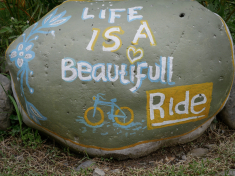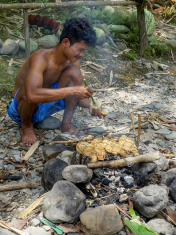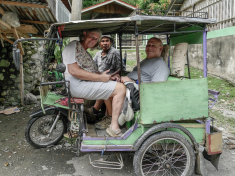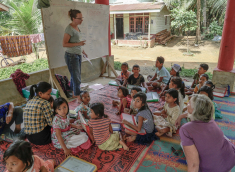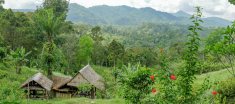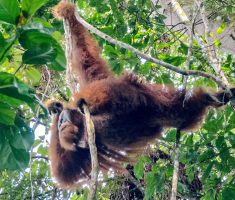We trekked in Gunung Leuser National Park (GLNP). It is one of the most biologically diverse habitats on the planet. The region is located in a remote part of Indonesia’s largest island and straddles the provinces of North Sumatra and Aceh. It is a land where mountains rise sharply from the lowlands with peaks that stretch out and into the clouds. The jungle, scarred at times with the occasional blemish of illegal palms, appears as an impenetrable giant green wall. It is a place where butterflies, insects and birds flutter about as though you’re in a giant terrarium. It is the incarnation of Avatar’s tropical world.
After an early morning breakfast of banana crepes and iced cappuccino, we crossed the Bohorok River. This river marks the start of the jungle trek trail. Do you remember that David is afraid of heights? Especially, if things are moving in an unpredictable fashion. The bridge swings, sways, creaks, is missing more than a few boards — you notice the sign that says no more than 6 orangs at any given time.
Orangutans share 97% of their genes with us. Lurking beneath those thick orange furs are the great ape’s deep, intelligent, searching eyes and uncanny human-like behavior. Orangutans live mostly solitary lives. They spend nearly all their time in the treetops, they wander widely, and for the most part they inhabit rugged forest or swampy lowland that’s hard for humans to traverse.
In the 1980’s and 90’s, some conservationists predicted that orangutans (orang = people, utan = forest, orangutan = people of the forest) would go extinct in the wild within 20 or 30 years. Fortunately that didn’t happen. Many thousands more orangutans are now known to exist than were recognized at the turn of the millennium. This doesn’t mean that all is well in the orangutans’ world. The higher figures come thanks to improved survey methods and the discovery of previously unknown populations. Conservationists on Sumatra estimate that only 6,000 survive there. Much of this loss has been driven by habitat destruction from logging and the rapid spread of vast plantations of oil palm, the fruit is sold to make oil used in cooking and in many food products. Animals can neither live in the palm plantations or off them, rendering the land biologically barren.
For centuries, scientists considered all orangutans to belong to one species, but in the past two decades new insights led researchers to see Bornean and Sumatran orangutans as distinct species, both of which are critically endangered. (In late 2017, a new species was identified in western Sumatra, genetically closer to the Bornean orangutan than the other Sumatran populations. It is distinct enough to potentially constitute a third species.)
Bukit Lawang, a village of around 3,000 people is the gateway to the adjacent GLNP. While you have to walk 15 minutes on a sidewalk from the roadway, the quaint surroundings are not primitive. Wander through local shops and you can buy trinkets and any kind of food — and you know your money goes to the locals. Or stop for a Bintang beer or banana juice on a balcony overlooking the meandering Bohorok River. Accommodation is authentic and affordable, often made from timber or other local materials.
The high-pitched, dental drill sound of cicadas fills the air, its the end of the wet season and the intense heat and supreme humidity create a steamy reminder that you’re deep in the tropics. The tracks are narrow and at times crude, but its wondrous to be surrounded by the visceral sights, smells and feel of the jungle; you could very well be in another century.
It is hard to describe what a humid, wet place the rainforest is. It might be 80 or 90 degrees, but with the high humidity, you’d feel like it was much hotter. David’s intolerance with heat and high humidity left him soaked in sweat. Although March is the “end” of the wet season every day there was rain. Sometimes a full force rainforest storm! The rain, usually was after our trek and during the evening hours, falls in buckets, full on wet with a lightning show the like of which I have never seen before. We sat in the dark in awe, (the electricity for the town goes out with the storm, which aids the light-show). In our guesthouse, there were 2 streams: directly beside and 50 feet in front of our room. There is nothing like going to sleep at night with the sound of a tropical rainstorm pouring down huge drops of water on your tin roof. After a hot day, the relative cool that accompanies the ran and the mesmerizing sound of the drops is a simple pleasure than cannot be compared, as you pull your sheet over yourself to fend off the damp cool that filters in through the screen windows.
After trekking for only an hour, wet through and through with sweat, our guide looks over his shoulder and says “orangutans ahead”. The aches in my legs disappeared, my adrenaline popped up and it was easy to move on down the trail. The sweat seemed a small price to pay for the privilege of seeing an endangered animal in the wild. We were so hot at some point, the guide found a giant leaf from the ground to fan David: “Sumatran air conditioning” he says.
At one point I was standing beneath a tree, above me the orangutan stretched out his arms to their full span, moved through the canopy by using his long-fingered hands and dexterous feet to clamber from branch to branch. The tree bent like a bow as his weight shifted, the guide pulled me out of the way, worrying that the branch would break, not that the orang would lose his grip. The orang had his eye on a young female a few trees over, and as she moved further into the jungle, he followed. Mating season is about to begin. Female orangutans give birth only every six to nine years. They actively rear their young for five years and support an active juvenile for another year or two. In the wild they may live as long as 55 years.
The rainforest is teeming with wildlife. Long-tailed macaques swing by to check you out and Thomas leaf monkeys, identifiable by their small head and triple Mohawk black and white fur, are not uncommon. We saw an entire family of white handed gibbons! They really have white hands! For the first time I saw a walking stick insect, about 5 inches long, it froze when we stopped to look at it. I am amazed the guides could find such a small, perfectly camouflaged insect..
We trekked in a 180 degree arc… we finished the day with only three miles of trekking and we once again encountered the river. “Jungle taxi” will take you back to town… there we go, floating down the Bohorok River with an inflated tube for approximately 30 minutes. A little bit of adrenaline, a splash of cold water and a whole lot of fun! We walked exhausted, but satisfied, back to Green Hill where we tucked straight into bed for a well deserved nap.
Which brings me to the story of the guesthouse. The staff, Tyson, Tameron, Ephram, Moose were the perfect hosts. Anton was a knowledgeable and patient guide. The luxury of staying a week allowed us to relax and have long easy conversations with the guys. We spent a day with each one, either trekking or having a picnic by the river. We are used to being the oldest guests, but these 20 somethings were so proud that we were healthy and willing enough to take on the challenges of the world.
The owners of Green Hill, Embra and his wife Andrea, a biologist and conservationist uses the funds from the guesthouse to support a school and library in one of the smallest villages. We brought school supplies to share and were lucky enough to go to a lesson. The kids here attend public school 5.5 days a week and come to English and art lessons on Sunday. Can you imagine kids in the USA going to school 7 days a week? That day, 21 kids came, Andrea said it was normally 35. There are lessons about conservation since these kids and their families literally live on the edge of the National Park and the future is in their hands.


